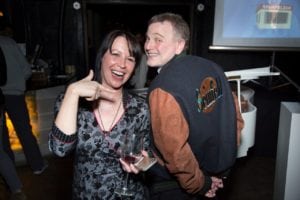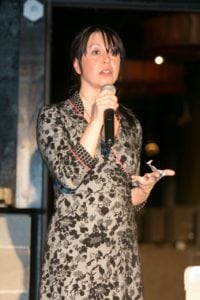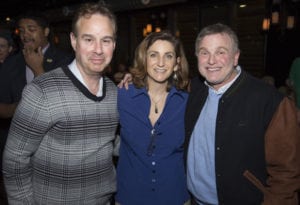
“Seinfeldia” author Jennifer Keishin Armstrong and score composer Jonathan Wolff mug for the camera at the March 4 J program about the iconic sitcom. (photo by Ted Wirth)
A show about nothing turned into something at Theatre Marketplace. The author of the book Seinfeldia, Jennifer Keishin Armstrong, along with the show’s musical creator, Louisville’s own Jonathan Wolff, told stories, showed video clips and examined the cultural impact of the comedy classic.
“The thing that surprised me the most is how vibrant the continuing fan culture is,” Armstrong said. “There are still Twitter wars over Seinfeld, and big events. I went to a trivia event that was so intense. People know so much about it that they have to make the trivia questions incredibly hard. It’s incredible.”
Nothing was off limits during the March 4 discussion, presented by the Jewish Community Center. From famous catchphrases like “yada, yada, yada,” and “No Soup for You”, to the inspiration for famous scenes like Elaine trying to dance, to the show’s music itself, the audience learned there was a reason for just about every plotline.
Wolff described an early meeting he had with creators Jerry Seinfeld and Larry David about why he wanted a bass to be a prominent part of the program.
“Jerry came over to my place. We watched some of his comedy. I noticed his delivery had a rhythmic lilt to it,” Wolff said. “I put a clock on it. It was about 1:10. That became the tempo. I explained we would use a bass. I created a bass line that was so simple, it did not require four beats to hold water. You could start and stop, to allow for the timing of his jokes and his laughs. I knew each monologue would have different timing, so I would need to create a new piece of music for every monologue that we did on Seinfeld. Those were the parameters I set up for myself.”
Wolff sees the show’s music as part of its signature. “You need an identifiable signature, so when people hear it from the other room, they will have that Pavlovian response,” He said. “It seems to be surviving. It has legs.”
The first Seinfeld episode aired in a less-than-desirable time slot, right in the middle of vacation season, July 5, 1989. NBC originally committed to just four episodes. As the show started resonating, the audience and ratings both grew.
Armstrong said the key to the show was a very basic concept. It was funny.
“That’s more significant than it sounds,” she said. “What they were trying to do with this show is concentrate on comedy, that nothing else matters except to be funny. They succeeded and it worked.”
Armstrong said every episode was based on real life. For example, Elaine’s confusing and laughable dance steps, according to the author’s research, were influenced by none other than the moves of Saturday Night Live creator Lorne Michaels.
The episode where Kramer starts the J Peterman Reality Bus Tour was inspired by a bus tour given by Kenny Kramer. He’s the real man upon whom the character Cosmo Kramer is based.
Seinfeld ran for nine seasons and 169 episodes. Most of them are loved. Then there’s the finale, which the website vulture.com ranked as the third worst Seinfeld episode.
“I’ve become a defender of the finale,” Armstrong said. “A lot of people hated that finale. I encourage people to watch it again, because part of their disappointment was the hype around it. I’ve watched it many times, for this book. It was a good piece of art on its own. I always say what did you want, to see Elaine and Jerry getting married? No, I don’t want to see that. That’s disgusting.
“The only other option was for the finale to do a completely normal episode and pretend it’s not a finale at all,” she continued. “Seinfeld is all about how people are stuck together. They can’t get away from each other. They’ll always be together until the day they die.”
The Louisville audience was fortunate to see Armstrong and Wolff together. While Armstrong will continue with her book tour, Wolff retired from show business years ago. After working 75 prime time network TV series, he decided to raise his family here in Louisville.
“Our family needed me more than Hollywood needed my music,” he said. “So we went to Louisville, and lived a quiet life where I could be a full-time PTA parent, field trip chaperone, and assistant coach. We have four kids who were raised in the Jewish community. I still have two in high school. We’ve really enjoyed it.
“Now that they’re older, they don’t need me as much,” he added. “I travel. I give lectures at universities. I give concerts, where I tell stories from the piano. It’s fun. I left because it was time. It was something I learned from Seinfeld, to go out on top.”






